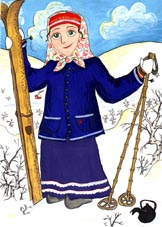| |
|
|
Beadwork, root and bark craft and hand-spun yarn…
The ample use of beadwork in headgear, belts and bags, and lately even
in men's broadcloth coats, is the most visible and impressive feature
of Skolt Sámi handicraft. Among the Skolt Sámi, the design
of a woman's head-dress depends on whether she is a maiden, a wife or
a widow. According to tradition, the hat has always been covered with
a scarf. Only when a woman was at home, among close relatives, could she
wear the hat without the scarf. In winter, Skolt Sámi men have
traditionally worn a handsome hat, which is made from broadcloth and decorated
with fox fur, beadwork, buttons and tassel bands.
In the region influenced by Russian and Karelian traditions, the traditional
woman's dress is one with shoulder straps - also known as a sarafani.
On top of the dress, the woman has a tight-fitting shirt, kurtta,
which is decorated with pintucks and lace. In the summer, she wore shoes
made from reindeer leather and laced with decorative bands, and, in winter,
reindeer fur shoes. Socks, mittens and blankets were traditionally made
from sheep wool. The wool was spun with a distaff into a yarn the thickness
of which suited the purpose. Skolt Sámi mittens are well-known
for their shape, decorative pattern and combination of colors, and each
maker or the knitters of a whole village have their characteristic designs.
However, Marfa Orttonen, a well-known handicraftswoman, put the theories
of how to knit mittens shortly into one sentence: "The freezing
weather is the best teacher of designs!"
The Skolt Sámi woollen wall hanging was originally used as a blanket
to cover children or sheep when travelling with sledges from the winter
village to the spring quarters. The wall hanging is made with a vertical
loom - as nomadic people do all around the world. The best-known weavers
of recent decades, Anastasia Moshnikoff and Darja Jefremoff, showed how
to weave such blankets at the Antti farmstead in the Seurasaari Open-Air
Museum in Helsinki in the 1950s. In connection with this visit, the making
of a Skolt Sámi wall hanging in all its details was also documented
on film.
Bark and root craft were especially mastered by the Skolt Sámi
living in the Suonikylä Lapp village, as there were pines and birches
growing in their family lands. Both pine and birch root were used in this
craft: in baskets, containers and sugar bowls. When making dishes from
bark, root was used for the sewing. The tradition of root craft has been
passed down to the present Skolt Sámi generations by Domna Fofonoff
- a skilled maker of handicraft - and her work has been carried on by
the master-craftswoman Matleena Fofonoff.
 |
| Illustration by Tanja Sanila. |
In Sevettijärvi, Nellim and Keväjärvi, courses have been
arranged in almost all the fields of traditional Skolt Sámi handicraft.
The prospects for the heritage to survive are good. Traditional handicraft
is also - to some extent - made for sale and available in Sevettijärvi,
Inari and Nellim.
Skolt Sámi visual artists Tarja Sanila and Virpi Jefremoff have
depicted the Skolt Sámi life, traditions and clothing in their
art. Tarja Sanila's works have been printed as illustrations in books
and as cards. Minna Moshnikoff has made a web
site on the the Skolt Sámi and life in Sevettijärvi (in
Finnish).
|
|
